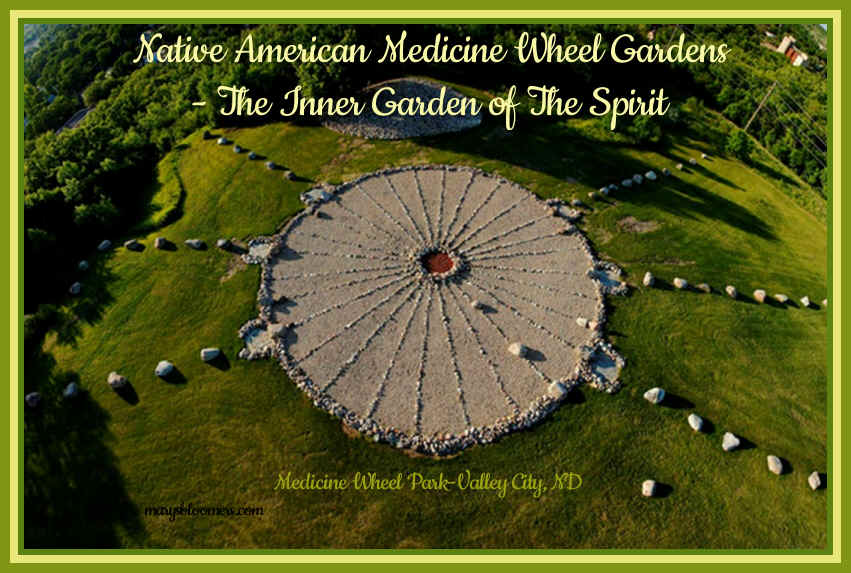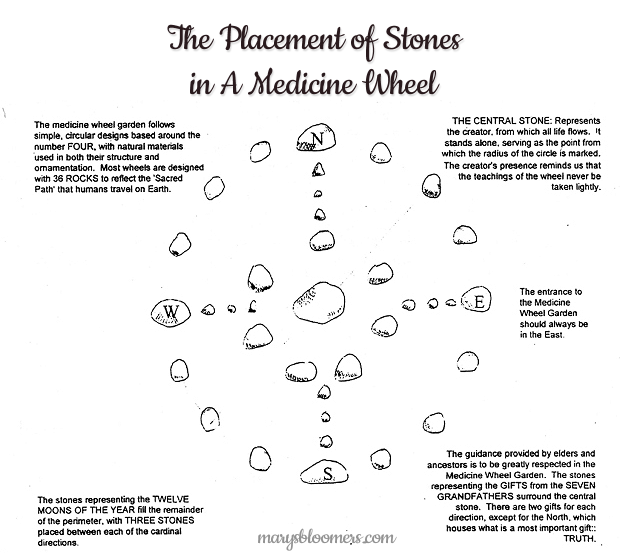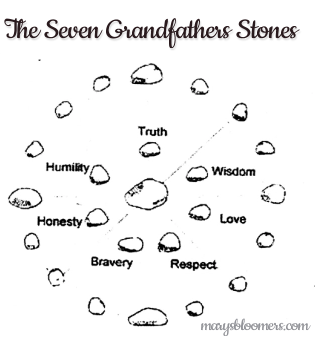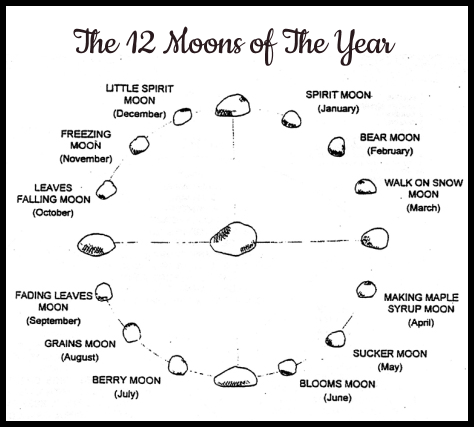|
|
A Native American Medicine Wheel Garden is specifically designed to be deeply personal, and your choice of plants, natural materials and symbolic garden decor reflects the inner garden of your spirit. There is much to learn from the sacred medicine wheel. Primitive cultures displayed a reverence for the Earth through sacred rituals, ceremonies, blessings, cleansing and visions. Native Americans gave thanks, asked for guidance, displayed a keen intuition, and they understood their world on many inner spiritual levels, through these gardens. Medicine wheels are based on the sacred natural shape, that is symbolic of the connection of all living things. Their round designs feature a central focus, and four or more paths carve the garden into pie-shaped beds. Most are planted with perennial and annual herbs, some featuring medicinal herbs, others encompassing a wide variety of culinary, ornamental and healing herbs, native grasses, shrubs and cacti. For more than 5,000 years, natives of the Western Hemisphere built sacred circle structures, surrounded by one or more concentric circles, with spokes or stone lines radiating outward. Based on the number four (representing the cardinal directions situated at energy vortexes), sacred circles were used all over the world for ceremonies, as places of worship and to communicate creation stories. Rich in symbolism and powerful as healing places, these edifices stand testament to nature-based and deeply spiritual cultures. Most wheels are designed with 36 stones to reflect the ‘Sacred Path’ that humans travel on Earth. The garden’s entrance is always situated in the East, representing the beginning of our journey and the rising of the sun. History tells us that some 20,000 human-formed stone circles greeted migrating Europeans as they traveled westward. Situated on and around the Great Plains of Saskatchewan, Alberta, North Dakota, Montana and Wyoming, today less than 200 of these incredible ancient wheels have survived. Medicine Wheel Gardens do not need to be large. An average of 8 feet in diameter can grow plenty of culinary, butterfly and medicinal herbs in four distinct beds. The garden wheel must be situated in the open, with any tall trees or structures to the north. Herb plantss need about 8 hours of full sun per day. Each direction in the wheel has
relative meaning to an individual’s existence on Earth. Areas
for specific prayer can be designed into each wheel. Your family
members and pets can also be represented within the wheel |
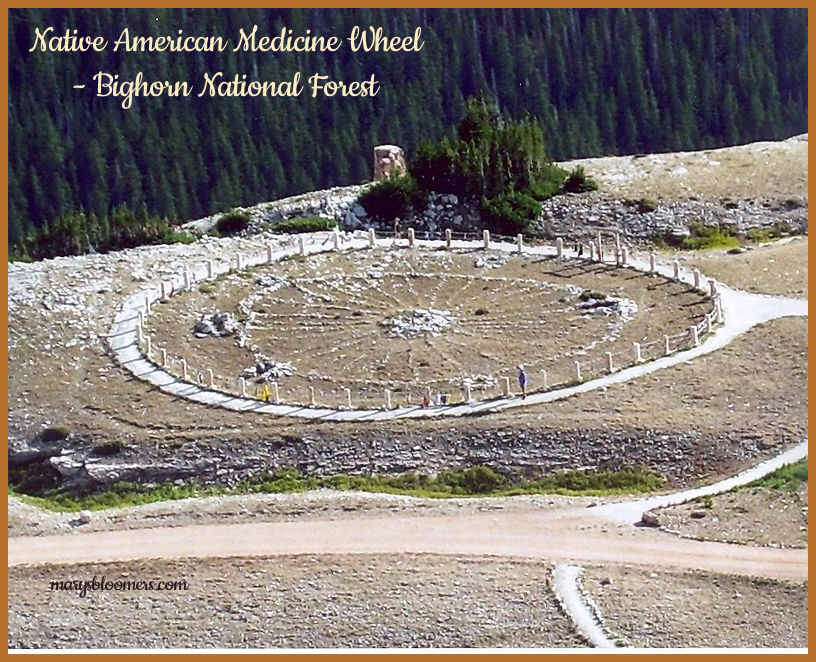 |
To create a medicine wheel garden, gather five marker stakes, a hammer, measuring tape, compass and some white string or landscaper's marking spray. Rocks mark the important yearly dates around the outside circle, so a rock pile would be very convenient. I use a lot of rocks and gravel for my landscapes, and there are plenty around to choose from. To start the wheel, drive a stake into the ground at the desired center. Using a compass, locate the four cardinal directions, and mark each with a stake 4 feet from the center. Mark the circle by joining the four cardinal direction stakes with string. Once the circle is marked, prepare the circle garden bed as you would your others. To view some ornamental circular gardens for a bit of garden prep or plant choice perspective, you'll find photos on this page. If the site you choose is on grass,
pull the grass out of the garden area, being careful to keep the five
stakes in place. Mix in potting soil, compost, and any other amendments
you use in your other garden beds. Herbs prefer well-drained,
slightly alkaline soil. Your other plant choices may require different
conditions. And you must cater to all of them for successful
growth. Use logs, pottery pieces,
bricks or smaller rocks to edge the paths and define the circle. Select plants for each quadrant, plant seedlings after the last frost, and allow at least 10 to 18 inches between each plant.
|
| Seven more
stones surround the Creator stone, inside the perimeter of the circle.
These are called The Elders and Ancestor stones. In Native American culture, focus is on the guidance provided by elders and ancestors that have travelled and experienced the path of The Medicine Wheel before us. These ancestors or ‘Seven
Grandfathers’ have gifts for us that have been translated from The
Creator. These seven gifts infuse the teachings of The Medicine Wheel. |
|
|
North Stone - White buffalo totem represents hibernation, suspension and significant inner growth; time to share knowledge, use restraint; the place for mental growth and wisdom. Plants for the North are plants that provide edible nuts or seeds. The sacred plant is Sweetgrass. Plants in these gardens should be planted for animals and wildlife, such as songbirds , bees and butterflies. Herbs grown are for mental health. Airy or feathery specimens that blow in the wind, like ornamental grasses, will help bring ones attention to the element of air, which is the element of the north. Ferns use the wind to distribute spores, and thrive in areas of the garden where sun is less intense. Plants with winter interest are also beneficial in this quadrant. South Stone - Coyote totem symbolizes growth and fulfillment; self-assurance and acceptance in humans; intense growth in plants; place of emotions. This is the place to meditate on relationships. The southern zones of the Medicine Wheel Garden are areas that bring intense growth in plants. Plants for the southern quadrant are plants that provide nutrition, such as fruits and vegetables, savory herbs, and plants that naturally assist other plants. The sacred plant is Cedar. Herbs for the south garden bring our attention to the earth, like ground covers or creepers. Creeping thyme is a wonderful herb in any quadrant. East Stone - Golden Eagle totem is the spiritual direction; representing new beginnings and creativity. In the East, every visitor’s journey begins. The East is the place for one’s spirit, and where one acknowledges the life given to us by the Sun. Plants for the eastern garden are herbs for spiritual health, plants for incense or smudging, and Spring blooms. The sacred plant for the East is Tobacco. West Stone - Grizzly bear totem represents maturity and experience. Some believe healing comes from this direction. This direction represents maturity and experience. The West is the place where the power of nature, and the physical body is often evident. Plants for the western garden are plants that grow edible roots. The sacred plant is Sage. This is where a rock garden should be designed if desired, as this is the place for minerals. Water features, or succulents will bring ones attention to how vital the element of water is for all living creatures. Flowers for autumn represent the season of the west. Moon Stones - Twelve stones around the perimeter indicate the 12 full moons cycles in a year.
Compilation Reources: |
|
|
Traditional Native American Three Sisters Companion Garden---> Native American Garden Herbs and Medicines---> List of Native American Herbal Remedies-->
Quick Links |
Content, graphics,
photos and design ©2020 marysbloomers.com
All rights reserved
